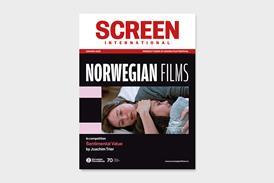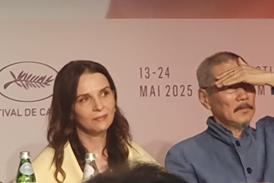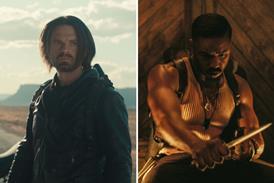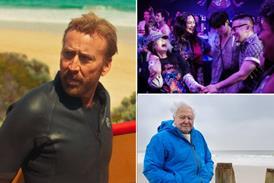This year’s festival saw 45% of its lineup coming from female directors, including Alone Together from Liza Minou Morberg [pictured].
Women took centre stage at Way Out West’s Film Festival, with head of film programming Svante Tidholm giving credit to 45% of its line-up deriving from female directors.
Headlining the film side of the joint music and film event was Alexandra Dahlström’s All We Have is Now that documents all-girl Swedish punk rock band Vulkano, and Liza Minou Morberg’s coming-of-age drama Alone Together detailing the friendship of three young women on their way to Way Out West.
Both films served as feature length directorial debuts.
“It was our privilege (and luck) to have two world premieres that were both directed by women, and also about strong women. We work closely with Sweden’s film industry, and one aim is to balance equality and gender. And from watching their films – you can immediately tell they are very talented filmmakers,” said Tidholm.
Theo Tasappos, project manager from Swedish Film Institute, also reiterated the importance of female directors, “Our aim is to have a 50/50 balance between female and male filmmakers, it’s a bonus if they focus around youth as well. Both Alexandra and Liza’s films are perfect examples of what we’re looking for. When Alexandra came to us for funding - I think everyone cheered.”
Dahlström is not new to Sweden’s limelight, having worked as Assistant AD and Russian translator on Lukas Moodysen’s Lilya 4-ever, and later starred in Moodysen’s Show Me Love and Tova Magnusson-Norling’s Fröken Sverige.
But her path took a different turn when she moved to Rome to further her life experiences.
“I learnt so much from working with Lukas and Tov and other Swedish filmmakers, but I knew I needed to forge new experiences. In Rome, I strangely secured a role in Dutch soap opera Good Times, Bad Times which gave me enough money to start directing short films and music videos,” said Dahlström.
When hearing the band Vulkano for the first time, she described it as “hearing music she has yearned for her whole life.” Though the punk rock duo eventually became her close friends, the filmmaker quietly began filming them with a small vintage Canon G12 bought from a garage sale.
When she couldn’t attend parts of their tour due to other filming commitments, the band themselves would take the camera, helping to give the documentary a raw, edgy context.
Filmmaker and producer Göran Hugo Olsson (Concerning Violence, Black Power Mixtape), came on board several years into shooting, and lent higher quality cameras and his professional support.
“Alexandra came to Story with very interesting footage, but we weren’t sure if it was material for television or a feature - sometimes you need to keep filming to determine these things,” said Olsson. “But we are thrilled with the film’s final version, and hope it will continue to tour the festival circuit.”
The film will be released in Sweden on October 24.
Liza Minou Morberg spends her time between Stockholm and Los Angeles, giving credit to the city of angels for her film degree at University of Southern California and a knowledge on how to make and sell a film for mainstream audiences.
“While the films I want to make are not necessarily Hollywood genre films, I understand what is important in terms of both narrative and visual storytelling.”
The burgeoning filmmaker drew inspiration for Alone Together from the underground youth culture that evokes sensations including love, happiness, doubt and sorrow, focusing particularly on issues young women face.
“I wanted to make a film about youth and the questions they have about their purpose in life – a time of freedom but also a time of angst. That interim period between adolescence and adulthood - and with the added touch of girl power,” Morberg added.
Working on a roster of short films and music videos, including ‘My Heart is Refusing Me’ from 2012 Eurovision Song Contest winner Loreen, Morberg had built a network of film contacts in Los Angeles.
But when a friend said female filmmakers are needed in Sweden, she decided to use her home country as the backdrop for her first feature.
“I didn’t know anyone. I just started talking to as many people as I could. We had no budget but the script was getting a great response. And I learned – when you have a small budget – everyone wants a share of that tiny pot of money. But when you have zero in the bank, everyone jumps in and just gets on with it.”
The filmmaker found her lead that was “Swedish but in a hood-way” at a small party just one week before shooting. The cast and crew then shot for five days in Stockholm and five days in Gothenburg.
“We were incredibly lucky Way Out West gave us free reign to film at the (2012) festival. In my opinion, it’s one of the best festivals in the world, and I am excited to give it added attention.”
Editing on an off for two years, while traveling to and from Los Angeles for other work projects, Morberg breaths a sigh of relief the film is at last finished.
“We finished literally just a week prior to the festival. I am really pleased with the attention its getting here – now we will work backwards with financing and distribution. It’s not the ideal way of doing things – but I think it’s going to work,” said a hopeful Morberg.
She is next working on a feature length script, in the vein of Un Prophet, that she anticipates being shot in Sweden.


































No comments yet